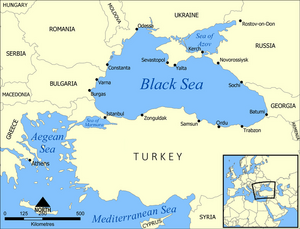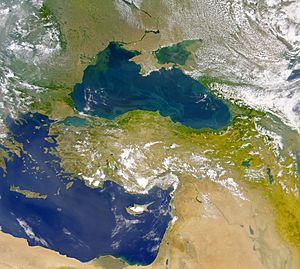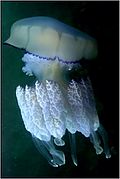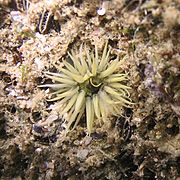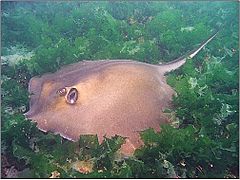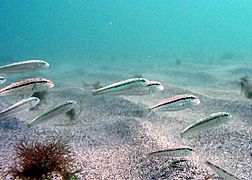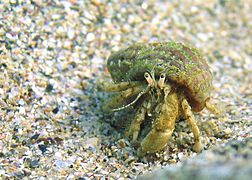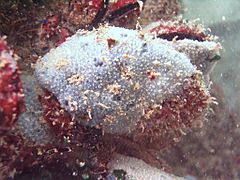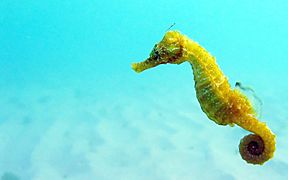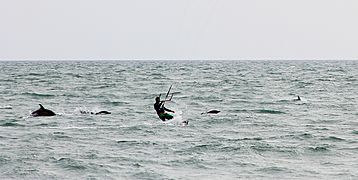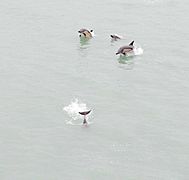Black Sea facts for kids
The Black Sea is a large sea located in Eurasia, between Europe, the Caucasus mountains, and Anatolia (modern-day Turkey). Many important rivers flow into it, such as the Don, Danube, and Dnieper.
The Black Sea is connected to the Atlantic through the Mediterranean Sea, Aegean Sea, and several narrow waterways called straits. A unique feature of the Black Sea is that about 90% of its deeper water has no oxygen. The water is salty, but less salty than the open ocean. Long ago, during the last ice age, the Black Sea was actually a freshwater lake!
Contents
A Look Back in Time: Black Sea History
In ancient Greek mythology, brave heroes like the Argonauts sailed across this sea. The ancient Greeks also set up many settlements around the Black Sea. This was because the sea was a very important route for trade between different countries. Later, during World War I, there was a big battle called the Gallipoli Campaign fought to control access to the Black Sea. It was also important during World War II.
How the Black Sea Was Formed: Geology
The Black Sea sits in a giant dip in the Earth's crust, like a huge bowl. This makes it a true inland sea, meaning it's almost completely surrounded by land. The deepest part of the sea is about 2,000 meters (about 6,500 feet) deep.
One of the most interesting things about the Black Sea is that its deep waters do not mix with the water closer to the surface. The surface water gets oxygen from the air, but the deep water doesn't. This means that over 90% of the Black Sea's deep water has no oxygen at all! The top layers of water are usually cooler, less dense, and less salty because they get a lot of fresh water from big rivers. The deeper waters are warmer and saltier, coming from the Mediterranean Sea.
The Crimean Peninsula divides the sea into two main parts. The narrow Bosporus and Dardanelles straits are the only connections between the Black Sea and the Mediterranean Sea.
Water Movement: Hydrology
The Black Sea is the world's largest body of water where the deep layers don't mix with the top layers. This is why its deep waters have no oxygen. The way water moves in the Black Sea is mostly controlled by the shape of the seabed and the fresh water flowing in from rivers. This creates strong layers of water that don't mix.
Water only flows in and out of the Black Sea through the Bosphorus and Dardanelles straits, connecting it to the Mediterranean Sea. The salty water flowing in from the Mediterranean is heavier and sinks to the bottom. The fresher water from the Black Sea's surface flows out into the Marmara Sea near the top. This means that more water flows out of the Black Sea than flows in, because of all the fresh river water.
Because the Bosphorus and Dardanelles are narrow and shallow, the water flows very fast through them. This causes some mixing between the layers. Surface water leaving the Black Sea is less salty, while the salty water entering from the Mediterranean becomes a bit less salty as it mixes.
The main surface currents in the Black Sea move in a big circle, like a giant whirlpool. This current, called the Rim Current, flows around the edges of the sea. Inside this big circle, there are two smaller circular currents, one in the east and one in the west.
Below the surface, there's a layer of cool, salty water called the Cold Intermediate Layer. This layer forms from cold surface waters in winter. Below this, the water gets even saltier and warmer, but it has no oxygen.
What's in the Water: Hydrochemistry
Because the deep water of the Black Sea has no oxygen, it's a great place for preserving things. Organic materials, including old shipwrecks, can stay in excellent condition for a very long time. Scientists have found ancient ships, like the Byzantine wreck called Sinop D, perfectly preserved in the oxygen-free layers off the coast of Sinop, Turkey.
Sometimes, there are reports of strange flares on the Black Sea during thunderstorms. These might be caused by lightning igniting natural gas that seeps up from the deep parts of the sea.
Life in the Black Sea: Ecology
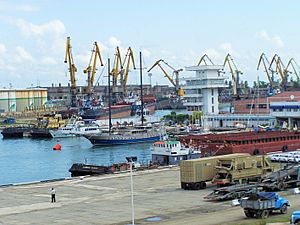
The Black Sea is home to a busy and active marine ecosystem. Many species have adapted to its unique conditions, which are a mix of fresh and salty water and rich in nutrients. Like all ocean food webs, the Black Sea has different groups of living things. Tiny algae, like diatoms and dinoflagellates, are the main producers of food.
Rivers flowing into the Black Sea bring a lot of sediment and nutrients. In winter, strong winds mix the water and bring nutrients up from the deep. In summer, the warm temperatures create layers that don't mix as much.
Tiny Plants of the Sea: Phytoplankton

The main types of tiny plant-like organisms (phytoplankton) in the Black Sea are dinoflagellates, diatoms, coccolithophores, and cyanobacteria. Usually, there's a big bloom of diatoms and dinoflagellates in spring. Then, in summer, a mix of different types grows below the surface. In autumn, there's another bloom closer to the surface. There's also a special bloom of a type of coccolithophore called Emiliania huxleyi in late spring and summer.
Amazing Animals of the Black Sea
- Zebra mussel: These mussels are originally from the Black Sea and Caspian Sea. They have spread to many other parts of the world and often become an invasive species, meaning they take over and harm local ecosystems.
- Common Carp: This fish is also native to the Black Sea, Caspian Sea, and Aral Sea. Like the zebra mussel, it can become an invasive species when introduced to new places.
- Round Goby: This is another native fish found in the Black Sea and Caspian Sea. It eats zebra mussels. It has also become an invasive species in other environments, like the Great Lakes.
- Marine Mammals: The Black Sea is home to two types of dolphins: the common dolphin and the bottlenose dolphin. Harbour porpoises also live here. Sadly, all these species are endangered because of human activities. These Black Sea populations are considered special types, different from those in the Mediterranean and Atlantic. Recently, building the Kerch Strait Bridge led to more nutrients and plankton in the water, attracting many fish and over 1,000 bottlenose dolphins.
* The critically endangered Mediterranean monk seal used to be common in the Black Sea but is now thought to be extinct there since 1997. * Some other marine animals, like grey seals and beluga whales, have been accidentally or purposely introduced to the Black Sea by humans and have sometimes managed to live there for a long time.
How Pollution Affects the Black Sea
Since the 1960s, a lot of industrial growth and dam building around the Black Sea has changed the balance of nutrients in the water. This has led to more frequent blooms of single types of phytoplankton, especially non-diatoms. These blooms can block sunlight, harming plants on the seabed. The lack of oxygen also causes many marine animals to die.
Overfishing in the 1970s also hurt the ecosystem. Later, an invasive comb jelly called Mnemiopsis greatly reduced the amount of copepods and other tiny animals that fish eat. Another alien species, the warty comb jelly, also took hold and grew to an enormous size.
Good news! Efforts to reduce pollution and new regulations have helped the Black Sea ecosystem start to recover since the 1990s. Scientists have seen signs of improvement, partly because new sewage treatment plants have been built in countries like Slovakia, Hungary, Romania, and Bulgaria. Also, another alien species has arrived that eats the Mnemiopsis leidyi, helping to control its population.
-
Hermit crab, Diogenes pugilator
-
Endangered Black Sea Common Dolphins with a kite-surfer off Sochi
-
Common dolphins porpoising with a ferry at Batumi port
Images for kids
-
Swallow's Nest in Crimea
-
A sanatorium in Sochi, Russia
-
Coast of the Black Sea at Ordu
-
The Black Sea near Constanța, Romania
-
The Bosporus, taken from the International Space Station
-
Map of the Dardanelles
-
Ivan Aivazovsky. Black Sea Fleet in the Bay of Theodosia, just before the Crimean War
See also
 In Spanish: Mar Negro para niños
In Spanish: Mar Negro para niños


